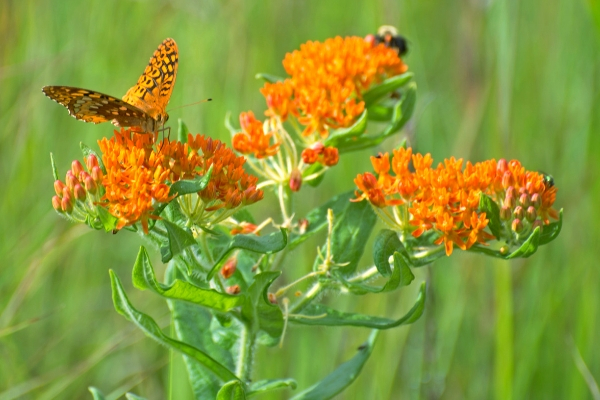Learn all about Butterfly Milkweed, or Asclepias tuberosa, in this gardener’s guide of this beautiful plant, including plant care, common types, and more.

The Butterfly Milkweed plant, or Asclepias tuberosa, is one of the best attractors for the iconic Monarch Butterfly that migrates every year between Mexico and the United States.
This plant is aptly named for its ability to attract Monarchs, as well as other butterflies, to gardens across North America. Plus, it also attracts many other kinds of pollinators.
Being a native plant from the Eastern United States, it is adaptable to different climates and can be lower maintenance than most other landscape plants due to its slight drought tolerance.
With beautiful, showy flowers that attract numerous pollinators, the Butterfly Milkweed can enhance your summer garden in more ways than one.
In this Butterfly Milkweed plant guide, you’ll learn the unique characteristics of this plant as well as basic plant care and where to buy them for yourself.
Quick Plant Care Facts
| Sun Exposure | Full sun |
| Water Needs | Needs moderate watering. |
| Soil Needs | Well-draining soil. |
| Cold-Hardiness Zones | USDA hardiness zones 3a to 9a. |
| Bloom Time | During Summer months. |
| Flower Colors | Flowers come in bright orange, with certain strains, like the 'Gay Butterfly' Strain, having yellow, red, orange, pink, and bicolored blossoms. |
| Mature Height/Width | Species grows 3 feet tall and 1 foot wide. Numerous stems grow every year from the root to form a small bushy-clump. |
| Plant Spacing | Plant on 1 foot or slightly less centers so plants grow into adjacent plants to give good coverage for weed control. If weeds aren't an issue then 1 foot or more centers is fine. |
Become a Plant Profile Club member here, if you want more butterfly milkweed plant care information than this!
[convertkit form=1655951]
Jump ahead to a specific section:
In addition to Butterfly Milkweed, there are many other beautiful milkweeds that all have similar characteristics. We’re affiliates for Eden Brothers and they have many milkweed seeds to offer which we highly recommend.
These specific Sunset Flower Milkweed seeds would be perfect for you! They are a native wildflower that are actually more colorful than Butterfly milkweed!
Plus, when you get to the Eden Brothers checkout, because we are affiliates (which means we receive a small commission at no cost to you which helps us run our website and podcast), use our special coupon code “SPOKEN” for an extra 15% off your order!!
Or, if you need to shop for other garden plants for this spring and summer, click the link below.
Click here for the most up to date deals and plants on Amazon!
Butterfly Milkweed: Why You Should Add This Plant to Your Garden
First, we all love pollinators and unfortunately, the Monarch butterfly population continues to be on the decline.
By learning more about one of their important caterpillar host plants, we can all do our part to help their numbers improve (as well as help support other types of butterflies).
In fact, milkweeds are native wildflowers which will attract many other types of pollinators as well.
In addition, milkweeds can be found in a variety of shapes, sizes, and colors. Depending on what you’re looking for, there is a probably a milkweed plant perfect for you
Plus, the Butterfly Milkweed plant is very low maintenance. With its full sun growth requirements, this beautiful plant will grace your garden year after year with its bright, orange flowers.
You can find more of butterfly milkweed care needs, when it flowers, its uses, and more by becoming a Plant Profile Club member.
Butterfly Milkweed Flowers: History and Types
Milkweed Family
Milkweeds are in the family Apocynaceae and the genus Asclepias. This family group, also known as the Dogbane family, includes trees, shrubs, herbs, vines, and succulents. Milkweeds are herbaceous, perennial plants known for their milky substance, known as latex.
With over 5,000 species, many members of this family are poisonous (some really toxic) and the plants are located all over the world. They are valued for a range of uses, including:
- Ornamental plants
- Prescription drugs
- Cleaning up oil spills
- Some cooking use (although very limited)
- Poison for arrows
- Filling for pillows
Other members of the large Apocynaceae family include milkweeds, vinca, oleander, and plumeria.
Butterfly Milkweed History
Butterfly Milkweed has a long, interesting history.
The genus was formally described by Carl Linnaeus in 1753, who named it after Asclepius, the Greek god of healing. This makes perfect sense since this plant has several medicinal uses throughout history.
In Greek mythology, Asclepias was the son of Apollo and was the demi-god of medicine, known for healing and good health. The Rod of Asclepias, the twisted snake around the staff, is still the main medical symbol today of most doctors and hospitals.
There is evidence that ancient Puebloans used fibers from the Butterfly weed in their textiles. In addition, many Native American tribes throughout history have used the Butterfly milkweed plant for making rope, cloth, medicine, and as a food source.
Some Native Americans learned to chew Butterfly weed roots as a remedy for some pulmonary issues. That’s why the Butterfly milkweed is also known as “pleurisy root.”
Another interesting use, during World War II, more than 5,000 tons of milkweed floss was collected in the United States as a substitute for other types of fiber.
Plus, as stated previously, milkweed is grown commercially as a hypoallergenic filling for pillows as well as insulation for winter coats.
This particular plant is native to the Eastern United States but can be found in Canada as well. Other milkweeds are located around the world in various climates.
Today, most milkweeds are enjoyed around the world for their ability to attract important butterflies, like the Monarch, and provide caterpillar host plants.
Types of Milkweed
Did you know there are 100 different types of native milkweed in the United States?
Just one of those plants could be the caterpillar host plant for a Monarch butterfly.
They differ by flower form, size, bloom time, and stem length.
And of course, there are many different colors to choose from.
- Common Milkweed
- Butterfly Milkweed
- Swamp Milkweed
- Purple Milkweed
- Mexican Butterfly Weed
- California Milkweed
- Bloodflower, or Sunset Flower Milkweed
Butterfly Milkweed Care
You can find more of butterfly milkweed care needs, when it flowers, its uses, and more by becoming a Plant Profile Club member.
How To Grow Butterfly Milkweed
First of all, not all seeds are created equal.
Our seed planting steps below are a guide for planting most seeds in general.
Milkweed Seed Planting Steps:
-
Read the seed packet label and follow their directions.
-
Choose an area according to the plant’s sunlight needs and water the soil first before planting.
-
Dig a trench at the recommended depth.
-
Place your seeds by planting one at a time according to the recommended spacing.
-
Lightly cover the seeds with the soil. According to the packet, firm down the soil as needed.
-
Water, water, water!
-
Wait for germination and then thin according to the packet directions for each seed.
Check out this video from Eden Brothers about their Milkweed seeds.
Milkweed Plants For Sale

Swamp Milkweed Seeds – Carmine, Fragrant/P…
Grow Butterfly Weed Seeds – Plant Swamp Milkweed Carmine Named Butterfly Weed for … [More]
Swamp Milkweed – White, Fragrant/Bright Wh…
Grow Butterfly Weed Seeds – Plant Swamp Milkweed White Crisp, white blooms atop lush… [More]
Bloodflower / Sunset Flower Seeds, Bright …
Grow Heirloom Bloodflowers / Sunset Flowers – Plant Bloodflower / Sunset Flower Seeds … [More]
Plus, when you get to the Eden Brothers checkout, because we are affiliates (which means we receive a small commission at no cost to you which helps us run our website and podcast), use our special coupon code “SPOKEN” for an extra 15% off your order!!
First, enter SPOKEN into their coupon code box (just like the first photo). You will know you received the coupon if you see the “coupon applied” notice (see the second photo).


Or, if you need to shop for other garden plants for this spring and summer, click the link below.
Click here for the most up to date deals and plants on Amazon!
Butterfly Weed Plant Conclusion
What plant, other than the Butterfly weed, can you think of that has had more interesting uses throughout history, is beneficial to Monarchs, and looks darn good doing it all?
Whether you want to attract pollinators, plant more native flowers, or enjoy its vibrant, orange summer flowers, this milkweed would make a great addition to your garden!
Now it is time to hear from you!
Why do you want to add Butterfly milkweed, or any type of milkweed, to your garden?
Leave a quick comment below and let us know!
Well, that’s all for now.
Thanks for reading and we hope you enjoyed our Butterfly Milkweed plant profile.
Want to learn about other plants in your garden? Check out some of our previous plant profiles:
- Primroses: A Gardener’s Guide and Plant Profile
- The Gardener’s Guide to Dianthus
- Grape Hyacinth: A Gardener’s Guide and Plant Profile
- Roses: A Gardener’s Guide and Plant Profile
- Sunflowers: A Gardener’s Guide and Plant Profile
See you in the garden!
~ Sean and Allison
P.S. Find us on Pinterest, Twitter, Facebook, and Instagram so you don’t miss a thing!
Butterfly Milkweed Plant References:
- “Butterfly Milkweed” – US Forest Service
- “Butterfly Milkweed” – USDA
- “21 Best Plants for Pollinators” – Sunset Magazine
Spokengarden.com is a participant in the Amazon Services LLC Associates Program, an affiliate advertising program designed to provide a means for sites to earn advertising fees by advertising and linking to Amazon.com

All about Butterfly Milkweed, or Asclepias tuberosa, in this gardener’s guide of this beautiful plant.





